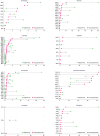Access to Cardiovascular Disease and Hypertension Medicines in Developing Countries: An Analysis of Essential Medicine Lists, Price, Availability, and Affordability
- PMID: 32338557
- PMCID: PMC7428558
- DOI: 10.1161/JAHA.119.015302
Access to Cardiovascular Disease and Hypertension Medicines in Developing Countries: An Analysis of Essential Medicine Lists, Price, Availability, and Affordability
Erratum in
-
Correction to: Access to Cardiovascular Disease and Hypertension Medicines in Developing Countries: An Analysis of Essential Medicine Lists, Price, Availability, and Affordability.J Am Heart Assoc. 2020 May 18;9(10):e014543. doi: 10.1161/JAHA.119.014543. Epub 2020 May 14. J Am Heart Assoc. 2020. PMID: 32406314 Free PMC article. No abstract available.
Abstract
Background Access to medicines is important for long-term care of cardiovascular diseases and hypertension. This study provides a cross-country assessment of availability, prices, and affordability of cardiovascular disease and hypertension medicines to identify areas for improvement in access to medication treatment. Methods and Results We used the World Health Organization online repository of national essential medicines lists (EMLs) for 53 countries to transcribe the information on the inclusion of 12 cardiovascular disease/hypertension medications within each country's essential medicines list. Data on availability, price, and affordability were obtained from 84 surveys in 59 countries that used the World Health Organization's Health Action International survey methodology. We summarized and compared the indicators across lowest-price generic and originator brand medicines in the public and private sectors and by country income groups. The average availability of the select medications was 54% in low- and lower-middle-income countries and 60% in high- and upper-middle-income countries, and was higher for generic (61%) than brand medicines (41%). The average patient median price ratio was 80.3 for brand and 16.7 for generic medicines and was higher for patients in low- and lower-middle-income countries compared with high- and upper-middle-income countries across all medicine categories. The costs of 1 month's antihypertensive medications were, on average, 6.0 days' wage for brand medicine and 1.8 days' wage for generics. Affordability was lower in low- and lower-middle-income countries than high- and upper-middle-income countries for both brand and generic medications. Conclusions The availability and accessibility of pharmaceuticals is an ongoing challenge for health systems. Low availability and high costs are major barriers to the use of and adherence to essential cardiovascular disease and antihypertensive medications worldwide, particularly in low- and lower-middle-income countries.
Keywords: cardiovascular disease; essential medicine lists; healthcare access; healthcare costs; hypertension; medication; price, availability, and affordability.
Figures








References
-
- World Health Organization . Cardiovascular diseases (CVDs) key facts. 2020. online. Available at: https://www.who.int/en/news-room/fact-sheets/detail/cardiovascular-d...). Accessed March 22, 2020.
-
- World Health Organization . Global Action Plan for the Prevention and Control of Noncommunicable Diseases 2013–2020. Geneva: World Health Organization; 2013.
-
- World Health Organization . A global brief on hypertension: silent killer, global public health crisis: World Health Day 2013. No. WHO/DCO/WHD/2013.2. World Health Organization; 2013.
-
- Collaborators, GBD , Forouzanfar MH, Alexander L, Bachman VF, Biryukov S, Brauer M, Casey D, Coates MM, Delwiche K, Estep K, Frostad JJ. Global, regional, and national comparative risk assessment of 79 behavioural, environmental and occupational, and metabolic risks or clusters of risks in 188 countries, 1990–2013: a systematic analysis for the Global Burden of Disease Study 2013. Lancet. 2015;386:2287–2323. - PMC - PubMed
Publication types
MeSH terms
Substances
LinkOut - more resources
Full Text Sources
Medical

